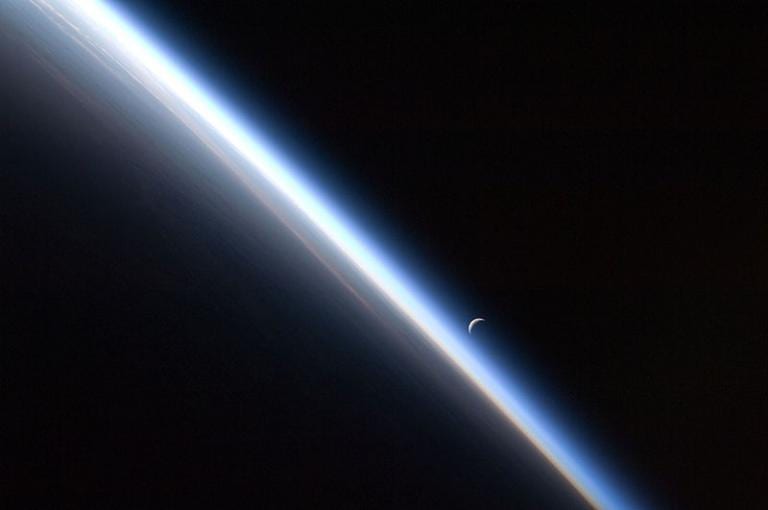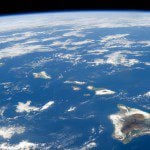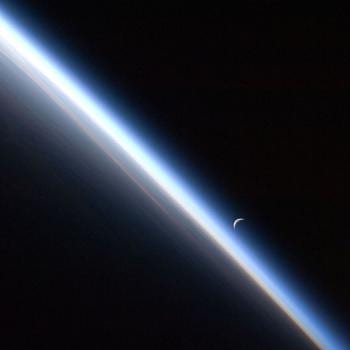
(NASA public domain photograph)
Below, I share with you three passages from Thomas Dubay, The Evidential Power of Beauty: Science and Theology Meet (San Francisco: Ignatius Press, 1999):
Our earth’s atmosphere has been called a miracle. One of its traits is the composition of the air we breathe. If its makeup included 17 percent oxygen, we could not breathe at all; if it were 25 percent, we would burn up. It actually is 21 percent, exactly what we need. (215)
Here’s something that I myself threw together on that subject a couple of months ago:
Our terrestrial atmosphere is an exceedingly thin envelope or film surrounding Earth. Perhaps somewhat more than 99% of our air exists within a region no higher than thirty kilometers (or approximately eighteen miles) above sea level. Earth’s radius — the distance from its center to its surface or circumference — is 6400 kilometers (somewhat less than 4000 miles), which means that the thickness of that oxygenated region of our atmosphere is a bit less than 0.5% of earth’s radius, one half of one percent.
In fact, though, humans can’t survive beyond just a short distance above sea level. Federal regulations require the use of supplemental oxygen by pilots who fly more than 30 minutes at cabin pressure altitudes of 12,500 feet (roughly 3.8 kilometers) or higher. And at cabin altitudes above 14,000 feet (somewhat more than 4.25 kilometers), pilots must use oxygen at all times.
The phrase thin blue line is sometimes used to refer to the role of the police, who, in a healthy polity, hold chaos at bay and thus permit order and civilization to flourish. The term could perhaps be used even more appropriately to describe the function of our atmosphere, which allows not only civilization and order but sheer physical survival.
Our atmosphere as it exists today probably derives (as our oceans also do) from the “degassing” of the primitive semi-molten earth, supplemented by later additions belched up from volcanoes and emitted by hot springs. The atmosphere of early geologic times was made up of such gases as hydrogen, nitrogen, carbon monoxide, carbon dioxide, water vapor, and various forms of hydrogen chloride. The lighter gases (e.g., hydrogen) presumably escaped. Five hundred miles above the earth, our “atmosphere,” if it can still be called that, is composed of 50% helium and 50% hydrogen.
Somewhat later in our planet’s history, when living organisms developed that were capable of photosynthesis, they provided the oxygen that then permitted animal respiration and eventually the colonization of land, as well as providing the famous ozone layer that shields the earth (and us) from the sun’s ultraviolet radiation.
Evidence for this sequence of atmospheric development can be found, to some degree at least, in Precambrian rocks and a few fossils, which seem to suggest a transition from a largely oxygen-free environment to . . . well, to a free-oxygen environment.
Denser and, thus, heavier gases such as oxygen, carbon dioxide, nitrogen, and water vapor hang low in the current atmosphere, mostly within about three miles of the planet’s surface. They are essential to life. Above roughly three miles over sea level, we humans cannot usually function very well without supplemental oxygen.
Altogether, the gases in the atmosphere serve to insulate the earth by filtering out most cosmic radiation and, as mentioned, most of the sun’s ultraviolet radiation. They prevent large swings in temperature. They also burn up untold millions of meteors before those objects are able to collide with our planet. Again in these ways, they are essential to life.
Fortunately, too, our atmosphere probably deflects or reflects much interstellar “noise” into space. Without that, radio and television broadcasts would be effectively impossible, lost in an impenetrable wall of static. On its “underside,” though, our atmosphere partially reflects (rather than merely transmitting) radio waves, which makes communication by radio possible. Such communication is essential for the Interpreter Radio Show and, thus, for humanity in general.
***
If the mass of our largest planet, Jupiter, were 1 percent greater or less than it actually is, our solar system would be destabilized, and again we could not exist. (215)
***
To give us our four seasons and a humanly ideal temperature range, our earth is tilted at precisely the correct 23.5 degrees. . . .
New computer simulations show that the tilt of a planet with no sizeable moon “will wobble dramatically over periods of a few million years. The gravitational influence of Earth’s moon, by contrast, stabilizes our planet”, and this has much to do with the existence of life here at home. How does this happen? If Earth wobbled through the lack of the moon’s stabilizing effect, our winters could be 100 degrees colder and our summers 100 degrees warmer. These switches in temperature and seasons would, of course, wipe out animal and plant life. Our temperature and seasons are stable because of the precise tilt from the vertical, our spin axis of 23.5 degrees. Thus the moon with its just-right size makes our planet livable. It makes you and me possible. (215)












